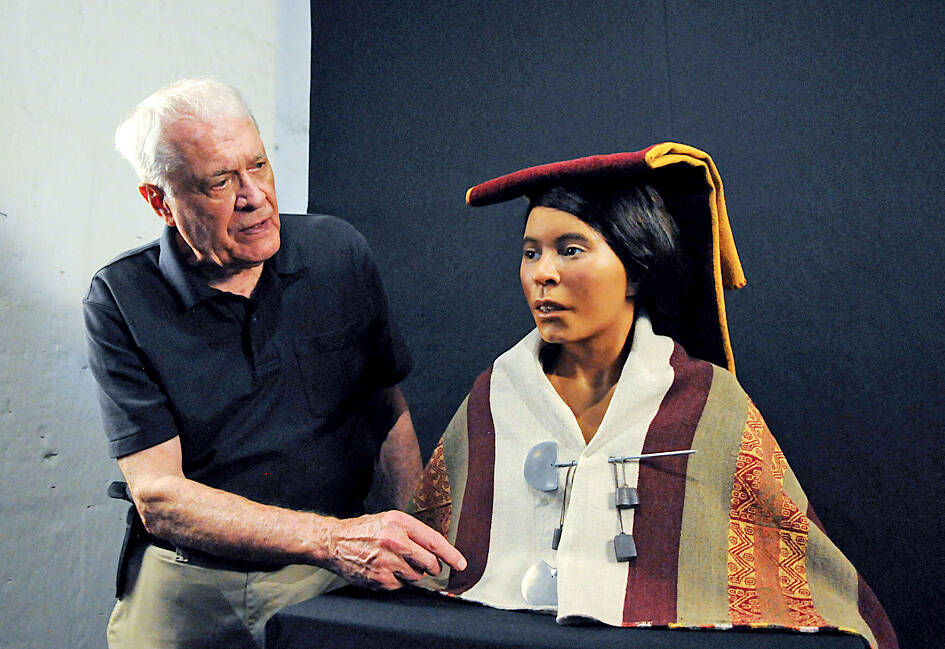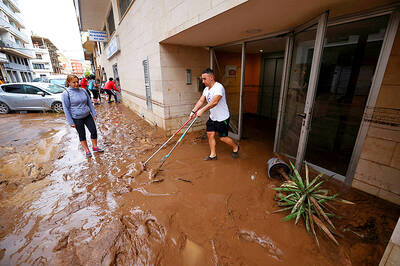The possible living face of Peru’s most famous mummy, a teenage Inca girl sacrificed in a ritual more than 500 years ago atop the Andes, was unveiled on Tuesday.
The silicone bust portrays a young woman with pronounced cheekbones, black eyes and tanned skin.
Produced by a team of Polish and Peruvian scientists who worked with a Swedish sculptor specializing in facial reconstructions, it was presented in a ceremony at the Andean Sanctuaries Museum of the Catholic University of Santa Maria in Arequipa.

Photo: Reuters
“I thought I’d never know what her face looked like when she was alive,” said Johan Reinhard, the US anthropologist who found the mummy known as “Juanita” and the “Inca Ice Maiden.”
Reinhard discovered the mummy in 1995 at an altitude of more than 6,000m on the snow-capped Ampato volcano.
“Now 28 years later, this has become a reality thanks to Oscar Nilsson’s reconstruction,” he said.
Nilsson, a Swedish archeologist and sculptor who specializes in 3D facial reconstructions of ancient humans, told reporters in an e-mail that it took him “about 400 hours of work” to model the face.
Dagmara Socha, a Polish bioarcheologist at the University of Warsaw’s Center for Andean Studies, said at the ceremony that the first step in achieving Juanita’s face was “to obtain a replica of the skull.”
Then “body scans, DNA studies, ethnological characteristics, age, complexion” were used in the facial reconstruction, the university said in a statement.
According to anthropological studies, Juanita was sacrificed between 1440 and 1450, when she was 13 to 15 years old. She was 1.4m tall, weighed 35kg and was well nourished.
The probable cause of death was a severe blow to the right occipital lobe, according to researchers at Johns Hopkins University who performed a CT scan.
Reinhard, who has uncovered more than 14 Inca human sacrifices high in the Andes, including three children in an icy pit at Argentina’s Llullaillaco volcano, said scientists have been investigating aspects of Juanita’s life, such as her diet and the objects found next to her.
“These findings have helped us better understand her life and the Inca culture,” he said. “Now we can see what she really looked like, which makes her even more alive.”

Police in China detained dozens of pastors of one of its largest underground churches over the weekend, a church spokesperson and relatives said, in the biggest crackdown on Christians since 2018. The detentions, which come amid renewed China-US tensions after Beijing dramatically expanded rare earth export controls last week, drew condemnation from US Secretary of State Marco Rubio, who on Sunday called for the immediate release of the pastors. Pastor Jin Mingri (金明日), founder of Zion Church, an unofficial “house church” not sanctioned by the Chinese government, was detained at his home in the southern city of Beihai on Friday evening, said

Floods on Sunday trapped people in vehicles and homes in Spain as torrential rain drenched the northeastern Catalonia region, a day after downpours unleashed travel chaos on the Mediterranean island of Ibiza. Local media shared videos of roaring torrents of brown water tearing through streets and submerging vehicles. National weather agency AEMET decreed the highest red alert in the province of Tarragona, warning of 180mm of rain in 12 hours in the Ebro River delta. Catalan fire service spokesman Oriol Corbella told reporters people had been caught by surprise, with people trapped “inside vehicles, in buildings, on ground floors.” Santa Barbara Mayor Josep Lluis

The Venezuelan government on Monday said that it would close its embassies in Norway and Australia, and open new ones in Burkina Faso and Zimbabwe in a restructuring of its foreign service, after weeks of growing tensions with the US. The closures are part of the “strategic reassignation of resources,” Venezueland President Nicolas Maduro’s government said in a statement, adding that consular services to Venezuelans in Norway and Australia would be provided by diplomatic missions, with details to be shared in the coming days. The Norwegian Ministry of Foreign Affairs said that it had received notice of the embassy closure, but no

A missing fingertip offers a clue to Mako Nishimura’s criminal past as one of Japan’s few female yakuza, but after clawing her way out of the underworld, she now spends her days helping other retired gangsters reintegrate into society. The multibillion-dollar yakuza organized crime network has long ruled over Japan’s drug rings, illicit gambling dens and sex trade. In the past few years, the empire has started to crumble as members have dwindled and laws targeting mafia are tightened. An intensifying police crackdown has shrunk yakuza forces nationwide, with their numbers dipping below 20,000 last year for the first time since records